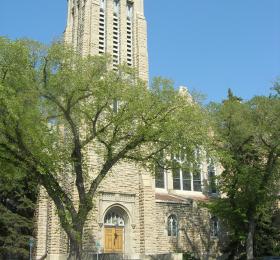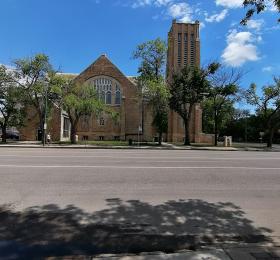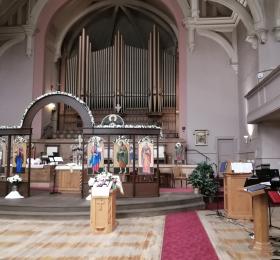Third Avenue United Church
- Designated
Description of the Historic Place
Third Avenue United Church is a pre-World War I, solid stone church based on the English Gothic architectural design. Constructed in 1911, the church is located in downtown Saskatoon.
This historic place, located at 304 3rd Avenue North, was designated as a Municipal Heritage Property in 2017. The designation is limited to the exterior of the building, the hammer-beam rafters and the Casavant organ.
Heritage Value
The heritage value of Third Avenue United Church lies in its architecture. During the boom time era Saskatoon was slated to become the mecca, or the "Hub City," of the prairies and it was only appropriate that its architecture should reflect the prominence which its citizens believed would be achieved in the next decade or so. The collapse of the economy across Western Canada in 1913 shattered those dreams, but the boom time era has left a legacy of substantial buildings which document the aspirations of Saskatoon's early citizens. Third Avenue Church is a prime example of that legacy, which was constructed by the Westside Methodist Congregation in 1911 on the northeast corner of 24th Street and 3rd Avenue. The building was designed in an English Gothic architectural style by John N. Semmens, a style defined by its pointed arches, vaulted roofs, buttresses, large windows, and spires. The church features lancelet windows and doorways and two tall towers (with one larger than the other). The base and foundation of the building are made of native limestone, processed within five miles of the city. The stone-work of the main body of the church is softly-tinted buff Tyndall stone from Winnipeg, while the trimmings are of pale grey-blue Tyndall stone.
The dominant features of the interior are the rafters and the windows. The lofty hammer-beam rafters of heavy dark oak crisscross the ceiling from a series of steel girder trusses. The west, south and east sides are adorned with a huge, arched, Gothic-style stained-glass window. The large Casavant organ is the main feature of the north wall. The baptismal font, communion rail and lectern are made of wood carved in a pattern which repeats the basic design of the windows. The basement of the church was designed to be modern and functional. There were about fifteen Sunday-school classrooms, ladies' and men's parlours, a library and a kitchen. The seating capacity of the church is approximately 1,600, excluding the choir-loft which accommodates up to fifty singers.
The heritage value of the Third Avenue Church also lies in its historical and cultural significance. Functioning as an auditorium in the early days of the city, it was and still is a popular venue for concerts. It has also hosted important political events. In November 24, 1921, for example, T. A. Crerar, leader of the National Progressive Party, appeared before a crowd of 3,000 supporters here, and in August 7, 1923 Aaron Sapiro, American pool expert, spoke to a crowd of 2,000. This meeting provided the backdrop for the formation of the Wheat Pool; and in the 1920s - CFQC Radio provided live broadcasts from the Church, including organ recitals. Convocation from the University of Saskatchewan, the Normal School and the City Hospital Nurses’ Training Program was held here for a number of years.
Over the years, the congregation has decreased but the graceful stone church has remained a landmark in the city, and in many ways a symbol of Saskatoon's development. Through the City’s Heritage Awards Program, Third Avenue United Church received an award for restoration of its exterior in 2004.
Source: City of Saskatoon Built Heritage Database
Character Defining Elements
Key elements which contribute to the heritage value of this historic resource include:
- Its English Gothic style of architecture, evident in: its lancelet doorways and windows, towers, rafters, pillars, pointed arches and stained glass windows;
- Its overall massing and symmetry, and the emphasis on verticality and light;
- Those elements that speak to its prairie history including its use of local and prairie materials such as the limestone and Tyndall stone façade; and
- Those elements that speak to its status as a cultural landmark, including its large Casavant organ and its orientation on its original lot.



